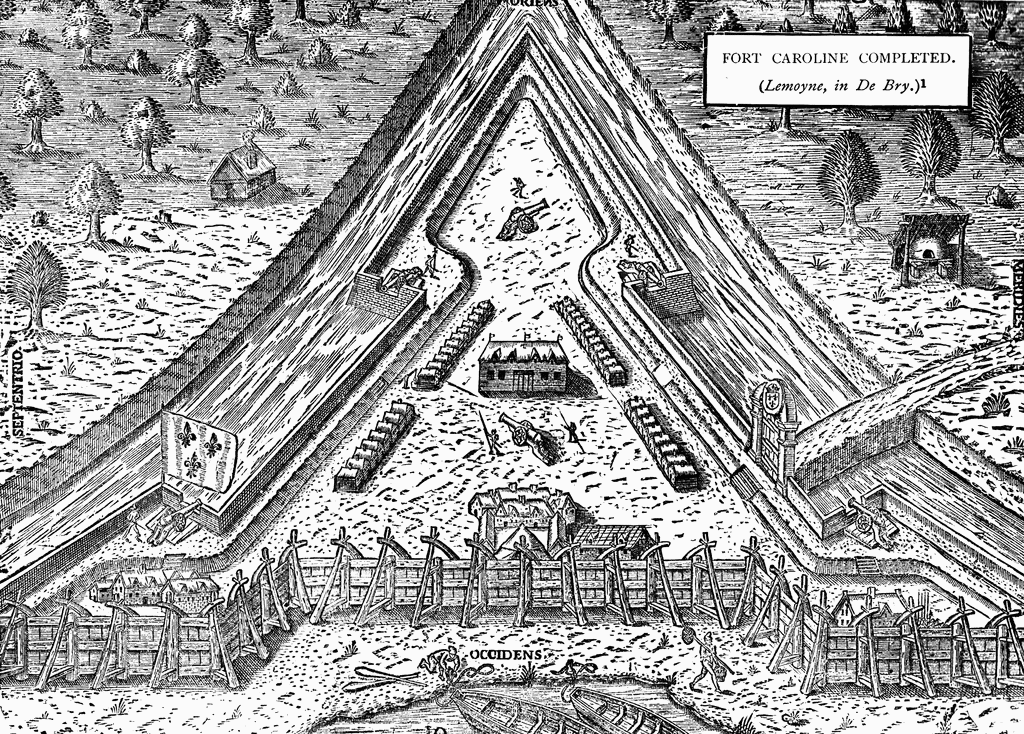Oldest fortified settlement ever found in North America
 |
Source: etc.usf.edu
An artist's rendering of Fort Caroline based on era des-
criptions. The site is yet to be excavated by archeologists.
|
Okay, writers of historical fiction. Here's a BIG one, the one you've been waiting for, the one with tremendous potential as a story source.
Here's the story:
. . .wait for it. . .
Oldest fortified settlement ever found in North America
In an announcement likely to rewrite the book on early colonization of the New World, two researchers today said they have discovered the oldest fortified settlement ever found in North America. Speaking at an international conference on France at Florida State University, the pair announced that they have located Fort Caroline, a long-sought fort built by the French in 1564."This is the oldest fortified settlement in the present United States," said historian Fletcher Crowe. "This fort is older than St. Augustine, considered to be the oldest continuously inhabited city in America. It's older than the Lost Colony of Virginia by 21 years; older than the 1607 fort of Jamestown by 45 years; and predates the landing of the Pilgrims in Massachusetts in 1620 by 56 years."
Announcement of the discovery of Fort Caroline was made during "La Floride Française: Florida, France, and the Francophone World," a conference hosted by FSU's Winthrop-King Institute for Contemporary French and Francophone Studies and its Institute on Napoleon and the French Revolution. The conference commemorates the cultural relations between France and Florida since the 16th century.
Researchers have been searching for actual remains of Fort Caroline for more than 150 years but had not found the actual site until now, Crowe said. The fort was long thought to be located east of downtown Jacksonville, Fla., on the south bank of the St. Johns River. The Fort Caroline National Memorial is located just east of Jacksonville's Dames Point Bridge, which spans the river.
However, Crowe and his co-author, Anita Spring, a professor emeritus of anthropology at the University of Florida, say that the legendary fort is actually located on an island at the mouth of the Altamaha River, two miles southeast of the city of Darien, Ga. Darien is located near the Georgia coast between Brunswick and Savannah, approximately 70 miles from the Jacksonville site.
To make the discovery, Crowe flew to Paris and conducted research at the Bibliothèque Nationale de France, the French equivalent of the U.S. Library of Congress. There he found a number of 16th-century maps that pinpointed the location of Fort Caroline. Some of the maps were in 16th-century French, some in Latin, some in Spanish, and some were even in English.
Crowe was able to match French maps from the 16th to 18th centuries of what is today the southeastern coast of the United States with coastal charts of the United States published by the National Oceanic and Atmospheric Administration, and with maps published by the U.S. Geological Survey.
One reason scholars claimed that Fort Caroline was located near Jacksonville is because, they believed, the local Indian tribes surrounding the fort spoke the Timucuan language, the Native American language of Northeast Florida.
 "We proved that the Native Americans living near the fort spoke a language called Guale (pronounced "WAH-lay")," Spring said. "The Guale speakers lived near Darien, Ga. They did not live in Northeast Florida, where Jacksonville is."
"We proved that the Native Americans living near the fort spoke a language called Guale (pronounced "WAH-lay")," Spring said. "The Guale speakers lived near Darien, Ga. They did not live in Northeast Florida, where Jacksonville is."
The two scholars believe that Fort Caroline lies on Rhetts Island, southeast of Darien. "The fort appears to be situated in an impoundment used for duck hunting in the fall," said Crowe, "and thankfully, the site is protected by the Georgia Department of Natural Resources."
"The frustrating and often acrimonious quest to find the fort has become a sort of American quest for the Holy Grail by archaeologists, historians and other scholars," he noted. "The inability to find the fort has made some wonder if it ever existed."

In 1565, Spanish soldiers under Pedro Menéndez marched into Fort Caroline and slaughtered some 143 men and women who were living there at the time. After the massacre, Menéndez wrote the king of Spain that he had discovered the French fort at "31 degrees North latitude." Using GoogleEarth, Crowe found the fort close to where the Spanish general had reported.
"The actual latitude of what we believe is Fort Caroline is well within the margin of error of 16th-century navigational instruments, about 17 miles," Crowe said.
French colonists at Fort Caroline were astonished by the dazzling amounts of gold and silver worn by the Indians near the fort. These reports were dismissed as fiction by previous researchers, who argued that North Florida has no deposits of either precious metal.
"We studied the trade routes of the Guale Indians and found that they led directly to the gold and silver deposits near Dahlonega, Ga.," Spring said. In 1828, Dahlonega became the site of America's first mint, and over the years about $600 million worth of gold, in 2013 dollars, has been recovered there.
For 150 years, scholars have thought that "French Florida" meant Northeast Florida, including Jacksonville, Lake City and Gainesville. The Crowe and Spring study is expected to fundamentally redefine the term.
Crowe noted that "French Florida forms a great oval extending from the Santee River of South Carolina, down to the St. Marys River, which serves today as the border between Georgia and Florida. French Florida extends from Darien on the coast, up to Milledgeville, east of Macon."
* * * * *
Story Source: Materials provided by Florida State University. "Oldest fortified settlement ever found in North America." ScienceDaily.


Comments
Post a Comment